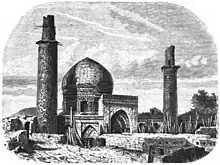| Shah Mosque | |
|---|---|
 | |
| Religion | |
| Affiliation | Islam |
| Province | Razavi Khorasan province |
| Location | |
| Location | Mashhad, Iran |
 Shown within Iran | |
| Geographic coordinates | 36°17′16″N 59°36′40″E / 36.2878905°N 59.6110778°E |
| Architecture | |
| Architect(s) | Ahmed ibn Shams al-Din Muhammad Tabrizi |
| Type | mausoleum, then mosque |
| Style | Timurid, Azeri |
| Date established | 1462 (as a mausoleum) |
| Completed | 1451 (as a mosque) |
| Specifications | |
| Dome(s) | 1 |
| Dome height (outer) | 17.4 metres |
| Minaret(s) | 2 |
| Minaret height |
|
| Materials | stone, brick |
The Shah Mosque, also known as the Haftado Dotan Mosque (Persian: مسجد هفتاد و دو تن, lit. 'Mosque of Seventy-two Martyrs')[1] since the Iranian Revolution, is a historic mosque located in Mashhad, Iran. It dates back to the Timurid period, and it is number 186 on the list of Iran's national heritage monuments.[1]
Haftado Dotan Mosque is adjacent to the Imam Reza Shrine, a holy place for the Twelver Shi'ites.[2][1]
History

Originally, at the site of the mosque, a mausoleum was built for the Timurid noble, Amir Ghiyath al-Din, known by his title "Malikshah".[3] Later on, it was expanded into a larger mosque, which was completed in 1451, and the mosque subsequently was known as the Shah Mosque.[2][1] Then, in the Safavid period, the mosque was renovated extensively by Soltan Hoseyn.[1] The final renovation was done during the rule of Nader Shah Afshar.[1]
Modern history
.JPG.webp)
Shah Mosque was listed as a national heritage site of Iran in 1893.[1] The mosque was renamed to "Haftado Dotan Mosque" after the Iranian Revolution, the word "Haftado Dotan" being Persian for seventy-two martyrs.[2][4] This was done in memory of the important people killed during the revolution, which numbered up to 72, coinciding with the number of casualties of the Ahlulbayt side in the Battle of Karbala. In modern times, the front portico of the mosque was converted into an office building and was closed to the public.[2]
Architecture

The mosque has a large, bulbous dome and two minarets which are not connected to it at all.[3][2] The bulbous dome is decorated with turquoise tiles and the inscription Allahus-Samad (which means God is Eternal) is embedded repeatedly in the design.[3][2] Currently, some of the designs on the dome are fading away. From the outside, the dome has a height of 17.4 metres, but it actually covers a smaller inner dome.[3][2] Underneath this inner dome is a crypt containing a tomb which is attributed to Amir Ghiyath al-Din Malik Shah.[3][2] The surfaces of the domed room are covered with dark-green tiles; both in the dado and above it, the rows of tiles are separated by some calligraphic inscriptions.[3][2] No mihrab is present, but a small niche in a wall which is pointed in the qibla direction can be seen in a room next to this domed room and crypt.[2] The southern minaret of the mosque is slightly ruined, and it is 15.4 metres in length.[3][5]
Gallery
See also
References
- 1 2 3 4 5 6 7 "مسجد هفتاد و دو تن مشهد | پیشینه و معماری + عکس – گردشی تاپ" (in Persian). Retrieved 2023-12-26.
- 1 2 3 4 5 6 7 8 9 10 "Archnet > Site > Masjid-i Shah". www.archnet.org. Retrieved 2023-12-26.
- 1 2 3 4 5 6 7 "آرامگاه «امیر غیاثالدین شاه ملک» - ایسنا". www.isna.ir. Retrieved 2023-12-26.
- ↑ "مسجد هفتاد و دو تن مشهد | آدرس + تاریخچه + اطلاعات بازدید". یومگ|مجله گردشگری یوتراوز (in Persian). 2022-05-10. Retrieved 2023-12-26.
- ↑ "مسجد شاه مشهد مسجدی به نام هفتاد و دو تن". www.eghamat24.com (in Persian). Retrieved 2023-12-26.


